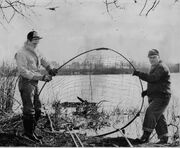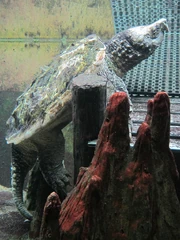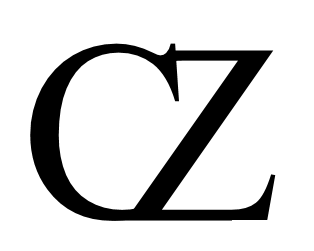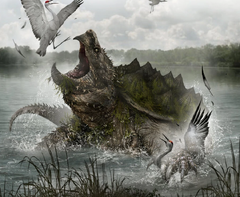| ||||||||||||||
The Beast of 'Busco, affectionately nicknamed Oscar, was an alleged giant alligator snapping turtle (Macrochelys cf. temminckii) reported from Fulk Lake, near Churubusco, northern Indiana in the United States, during the late 1940s. The story briefly gained national attention as a result of the increasingly-dramatic attempts by the lake's owner Gale Harris, and other locals, to capture the animal. Another giant turtle was reported from the state in 1950.[1][2]
Etymology[]
"Oscar" is usually thought to have been named after Oscar Fulk, the first alleged witness to the turtle.[3] However, Merl Leitch claimed that the name was bestowed in honour of a local realtor, Oscar Isay, an allegation denied by Isay's brother. Others insist that "Oscar" was always a generic name given to turtles in the area. Gale Harris, who owned the lake in which Oscar was seen, said that his son Vaughn had chosen the name.[4]
Physical evidence[]
Footage[]
During a March 1949 sighting, a man named Del Winegardner filmed the Beast of 'Busco from a tree. Two locals who saw the film, Merl Leitch and Dally Fogle or Dailey Fogel, said that the turtle was "clearly visible [in the film] just beneath the water level," and that it was as large as other eyewitnesses had claimed. Winegardner sold the film, and its current whereabouts are unknown.[5] Years later, Leitch recalled...[4]
| “ | I have a friend that clumb up a tree and took a picture, a movie of it, and I've often said that his head looked as big as a gallon crock and his back looked as big as the top of an old automobile.
|
” |
Attestations[]
The Churubusco farmland containing Fulk Lake, from which the Beast of 'Busco was reported, was originally owned by Oscar Fulk. When the Beast of 'Busco made the news in 1948, people who knew Fulk said that he had been telling stories of "a big turtle" fifty years before, in around 1898.[4] After Fulk sold his land, the new owners are said to have reported seeing the turtle in 1914.[1][3] A local named Pat Crooks was also told about a huge turtle in Fulk Lake years before the 1949 hunt. Giant turtles in the area may also figure in local Amerindian mythology. Gale Harris purchased the land on 14 November 1947, moving in with his wife Helen and son Vaughn, and one of the first things he learned was that a giant turtle allegedly lived in the lake.[4]
Sightings[]
1948[]
Ora Blue and Charley Wilson, brothers-in-law of Gale Harris, claimed to have had an encounter with the turtle on 27 July 1948. They claimed that the turtle "suddenly surfaced along side of their row boat" while they were fishing,[5][1] and some sources state that it tried to take their fishing poles.[3] They described it as having a head the size of a child's, and a back as broad as their boat.[5] According to Blue...[4]
| “ | We saw the big waves a-rolling and up came that turtle. I've never seen one so big. I saw that big head sticking up and the waves going away like a submarine.
|
” |
After hearing stories of the turtle from others, Gale Harris claimed to have finally seen it for himself in early Autumn 1948. Years afterwards, in 1971, Harris described his sighting to folklorist John Anthony Gutowski. According to Harris, his attention was first drawn to the creature by a church minister with whom he was patching a roof. The minister pointed out something moving across the lake:[4]
| “ | And I looked down there and I seen this big head. It was just like a big head and I said, "Oh, it just must be something, I don't know what it is".
|
” |
The pair ignored it for the time being, but the next day Harris and the minister noticed the shape again, swimming in the opposite direction. It took a journey of half a mile for them to reach the lake, by which time the shape had disappeared, so the two men went out onto the water in a boat.[4]
| “ | So we got in the boat and we seen something in the water. And he was looking down on the side of the boat and I was looking on this side of the boat. And he says, "Here it is over here". And I said, "No, here it is over here." "Well," he says, "it can't be". And I says, "Well, it is, right there it is. There's its tail." He says, "There's its head right over there." We had the boat right over it then and that turtle was that size then. You know, you look down on this side of the boat and see it here and on this side, it's a pretty good sized turtle.
|
” |
Harris estimated that the turtle was some 6' long and 4' wide, about the size of a dining room table, with a head the size of a baby's. He claimed to have seen the turtle on many subsequent occasions, more times that he could count. Harris and his son Vaughn reported another sighting in the autumn, while bringing in their cows. After sending Vaughn to fetch the rest of the family, Harris attempted to get closer to the turtle in a rowboat, allowing him to grab it by the tail. When he did so, it heaved out of the water and capsized the rowboat, forcing Harris to grab onto a tree limb.[4]
1949[]

One of the unsuccessful turtle traps, with Harris on the right.
Throughout 1949, local people made repeated attempts to capture the turtle, all of which failed. Gale Harris is said to have been particularly concerned with not injuring the animal, and "always had it in his head [that] we were gonna hurt that turtle," leading him to veto any plans which could harm it. While at first only a few men were engaged in the hunt, "the next day about sixty-five were out there".[4]
In the first week of March 1949, ten or eleven men made the first attempt to capture the turtle, and allegedly succeeded in cornering it "in about ten feet of water off the shore in a trap consisting of stakes and chicken wire". According to newspaper reports, it "was too strong," and broke through the barrier.[5] However, Merl Leitch later recalled a different story...[4]
| “ | There were about ten or eleven of us had him in a wire fence and we had him a' comin' in muck, you know. We knew we had him in there because we could see him a little. And we pulled him pretty well to the edge. I think if they'd kept on, of course they was pullin' a ton of muck along with it, you know. They was pullin' hard, and somebody spoke, "Well, let's let him go. We can't never pull him out." And I think if they'd kept on, they probably would of. But he was a big turtle.
|
” |
A man named Del Winegardner allegedly filmed the turtle from a tree at this time.[5] Farm worker Dick Zolman later claimed to have seen the turtle at an early stage of the "hunt"...[4]
| “ | The turtle was out about ten feet from the shore. He was sunnin' himself. I wanted to put an oar along side of him to see how long he was. But Harris, he didn't want to; he thought I'd scare him away. [...] I'd say [it was] about three and a half, four feet across, don't know how long, if coulda got that oar in there, oh, maybe six feet, six and a half. It was an awful big turtle. Big as anyone ever seen. He's down there now, probably dead covered with mud and tree limbs.
|
” |
In April, Oscar was allegedly seen in 40' deep water, coming up for fish. A net was thrown over the turtle, which tore a hole and escaped.[6] During another attempt, using a method apparently tried more than once, the turtle hunters managed to rope one of the animal's hind legs. Helen Harris, who claimed to have seen the turtle four times, later recalled...[4]
| “ | [...] we had got a rope on one of its hind legs, and we thought maybe we could gradually go towards shore and pull it along with us with this rope—get it up to the edge. [...] But the turtle broke the rope. We got so close to shore, and that's what happened every time. [...] And so after that happened, I saw him underwater, and you could see this piece of rope was about three feet long, still tied to his back leg, and he was swimming around with it on.
|
” |
Helen Harris' second sighting allegedly occurred when she was near the farm's hen house—on this occasion, she saw the turtle in its natural state, "sticking his neck and head up. And it looked just like a stovepipe with an elbow on. [...] And its head looked like it would be about the size of a baby's head". Another attempt at capturing the turtle, recounted by both Helen Harris and farmer George Wakeman, involved a large cage constructed using pipes. According to Harris...[4]
| “ | [...] we thought we had it in a cage. But they failed to make the cage big enough to go over the whole turtle. And they had the one side all in there fine, but on the other side where the cage came, it was right on his back. [...] we had put rails around it close enough. We thought it would hold till morning. And they was a gonna make another cage larger to put over it, but the next morning, the rails were pushed aside. And the turtle was gone.
|
” |
George Wakeman, who was present when Oscar was caged, remembered...[4]
| “ | I was up there when they were building the cage. He was in the dormant stage. This thing they had built out of pipe. It was eight feet across and that turtle, his head and tail were stickin' out of that thing. You'd have to say this turtle was four feet wide maybe seven feet long. That's my estimation. I seen him in the cage. [...] He was in about six feet of water. I should judge that the squares on his back were about four inches square. And he had a tail on him, oh, forty-two inches long. This turtle was over four feet across, close to five feet long. Pretty good sized turtle.
|
” |
By this time, the national media had picked up the story, and encouraged by the coverage, throughout 1949, thousands[1] of people gathered at Churubusco hoping to see or capture Oscar, including professional trappers and divers hired by Harris. Locals believed that the turtle was hibernating in the mud of the lake bottom, and attempts to drain the lake failed to reveal it. According to newspaper reports, the Beast of 'Busco made its final appearance on 13 October 1949,[1] when "in plain view of 200 people, he put on his most spectacular show when he leaped out of the water to feast on the live ducks set atop a trap".[5] Harris abandoned the hunt after his attempt to drain the lake failed, and he contracted appendicitis. With all his time spent hunting for the turtle, his farm failed, and he was forced to sell the property.[7]
1950[]
Another giant turtle was reported from Indiana in July 1950, this one from a swamp at Black Oak, some hundred miles from Churubusco. It was reported by Lake County surveyor Samuel E. Brownsten and farmer Henry Ewen, who were draining the swamp using a 30'' culvert into the Little Calumet River, when they noticed a large animal swimming towards them. Brownsten described it as "a turtle. It's head was as big as a human's," and Ewen stated...[2][8]
| “ | It was too big to even get into the thirty-inch drain. I tried to help it. I pushed on its shell, but man, when I saw the size of that thing, I knew I didn't want to tangle with it. It was as big as a beer barrel. [...] [It] could snap your hand off in second. His head is six inches across and he could hold a big orange in his mouth. At first, I thought it was an old moss-covered log. He had so much moss on him it looked like he was wearing a fur coat. I put my hand on him, thinking it was a log. Then he stuck his head out and looked me right in the eye. Gave me a turn.
|
” |
According to Ewen, it resembled an alligator snapping turtle, except that its shell "felt sort of smooth and rubbery". He nicknamed it Methuselah on account of its assumed old age, and admitted that the encounter had scared him enough to persuade him not to go looking for the turtle.[9]
Current status[]
Some believe that Oscar could theoretically still be alive,[10] as alligator snapping turtles can have extremely long lifespans. No sightings of giant turtles in Fulk Lake were reported after 1949, and Harris himself believed that Oscar had migrated into a different lake via a subterranean river, a theory suggested to him by "guys from zoos". Alternatively, the turtle may have survived within Lake Fulk by burying itself in the mud at the bottom and going into stasis, an eventuality which turtle collector Rust Reed finds unlikely, but possible. Reed believes that the Beast of 'Busco most likely died of suffocation after burying itself to avoid the draining.[7] Subsequent owners of the land have refused to allow the lake to be searched.[7]
Theories[]

An alligator snapping turtle (Macrochelys temminckii) at the Shedd Aquarium (Source).
On average, a normal alligator snapping turtle (Macrochelys temminckii), a species found in southern Indiana, weighs between 19 and 176 pounds, with a carapace length of up to 2' 5'', but much larger individuals have been verified. Loren Coleman notes that lower estimates of the Beast of 'Busco's weight are within the known range of the alligator snapping turtle:[2] a 249 pound specimen lived in Chicago's Shedd Aquarium, and an alleged 403-pounder was reported to have been caught in Kansas during the early 20th Century.[2] Rust Reed suggests that Oscar's size was dramatically overestimated by eyewitnesses, who he believes may have been misled by partial views, or by the disproportionately large head of the alligator snapping turtle. Others suggest the entire saga was a hoax originated by locals and stoked by the media,[7] and Churubusco farmer O. E. Jones, from whom Gale Harris had purchased his property, claimed that the alleged turtle was in fact "[his] Black Angus cow swimming around".[5]
Mark A. Hall speculates that alleged "oversized" snapping turtle specimens such as the Beast of 'Busco and the Black Oak turtle may have been forced to move closer to human communities because of habitat destruction caused by the draining of swamps to make way for farmland.[2][8]
In popular culture[]
- In celebration of Oscar, a "Turtle Days" festival is held in Churubusco each June, featuring a parade, a carnival, and turtle races. The Churubusco city centre also featured a statue of a turtle.
Notes and references[]
- ↑ 1.0 1.1 1.2 1.3 1.4 Eberhart, George M. (2002) Mysterious Creatures: A Guide to Cryptozoology, ABC-CLIO, Inc., ISBN 1576072835
- ↑ 2.0 2.1 2.2 2.3 2.4 Coleman, Loren & Clark, Jerome (1999) Cryptozoology A to Z: The Encyclopedia of Loch Monsters, Sasquatch, Chupacabras, and Other Authentic Mysteries of Nature, Simon & Schuster, ISBN 978-0684856025
- ↑ 3.0 3.1 3.2 Budd, Deena West (2010) The Weiser Field Guide to Cryptozoology: Werewolves, Dragons, Skyfish, Lizard Men, and Other Fascinating Creatures Real and Mysterious, Weiser Books, ISBN 9781609250836
- ↑ 4.00 4.01 4.02 4.03 4.04 4.05 4.06 4.07 4.08 4.09 4.10 4.11 4.12 4.13 Gutowski, John Anthony "The Beast of 'Busco: An American Tradition," Midwestern Folklore Vol. 24 (1998)
- ↑ 5.0 5.1 5.2 5.3 5.4 5.5 5.6 Muirhead, Richard CRYPTOZOOLOGY ONLINE: Still on the Track: MUIRHEAD`S MYSTERIES: THE BEAST OF BUSCO forteanzoology.blogspot.com (2 December 2009) [Accessed 2 September 2020]
- ↑ Ferrer, Ed "Searching for 'Oscar', the 'Beast of Busco'" The Monitor: Newsletter of the Hoosier Herpetological Society Vol. 23, No. 9 (September 2012)
- ↑ 7.0 7.1 7.2 7.3 Michaels, Denver (2016) People are Seeing Something: A Survey of Lake Monsters in the United States and Canada, CreateSpace Independent Publishing Platform, ISBN 9781523322718
- ↑ 8.0 8.1 Hall, Mark A. (1991) Natural Mysteries: Monster Lizards, English Dragons, and Other Puzzling Animals, Mark A. Hall Publications and Research
- ↑ "Monster Turtle Reported In Indiana Area," The Pantagraph (17 July 1950)
- ↑ Weatherly, David (2020) Monsters at the Crossroads: Cryptids & Legends of Indiana, Leprechaun Press, ISBN 978-1945950186

